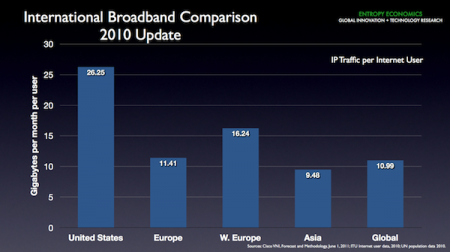The OECD published its annual Communications Outlook last week, and the 390 pages offer a wealth of information on all-things-Internet — fixed line, mobile, data traffic, price comparisons, etc. Among other remarkable findings, OECD notes that:
In 1960, only three countries — Canada, Sweden and the United States — had more than one phone for every four inhabitants. For most of what would become OECD countries a year later, the figure was less than 1 for every 10 inhabitants, and less than 1 in 100 in a couple of cases. At that time, the 84 million telephones in OECD countries represented 93% of the global total. Half a century later there are 1.7 billion telephones in OECD countries and a further 4.1 billion around the world. More than two in every three people on Earth now have a mobile phone.
Very useful stuff. But in recent times the report has also served as a chance for some to misrepresent the relative health of international broadband markets. The common refrain the past several years was that the U.S. had fallen way behind many European and Asian nations in broadband. The mantra that the U.S. is “15th in the world in broadband” — or 16th, 21st, 24th, take your pick — became a sort of common lament. Except it wasn’t true.
As we showed here, the second half of the two-thousand-aughts saw an American broadband boom. The Phoenix Center and others showed that the most cited stat in those previous OECD reports — broadband connections per 100 inhabitants — actually told you more about household size than broadband. And we developed metrics to better capture the overall health of a nation’s Internet market — IP traffic per Internet user and per capita.
Below you’ll see an update of the IP traffic per Internet user chart, built upon Cisco’s most recent (June 1, 2011) Visual Networking Index report. The numbers, as they did last year, show the U.S. leads every region of the world in the amount of IP traffic we generate and consume both in per user and per capita terms. Among nations, only South Korea tops the U.S., and only Canada matches the U.S.
Although Asia contains broadband stalwarts like Korea, Japan, and Singapore, it also has many laggards. If we compare the U.S. to the most uniformly advanced region, Western Europe, we find the U.S. generates 62% more traffic per user. (These figures are based on Cisco’s 2010 traffic estimates and the ITU’s 2010 Internet user numbers.)
As we noted last year, it’s not possible for the U.S. to both lead the world by a large margin in Internet usage and lag so far behind in broadband. We think these traffic per user and per capita figures show that our residential, mobile, and business broadband networks are among the world’s most advanced and ubiquitous.
Lots of other quantitative and qualitative evidence — from our smart-phone adoption rates to the breakthrough products and services of world-leading device (Apple), software (Google, Apple), and content companies (Netflix) — reaffirms the fairly obvious fact that the U.S. Internet ecosystem is in fact healthy, vibrant, and growing. Far from lagging, it leads the world in most of the important digital innovation indicators.
— Bret Swanson


